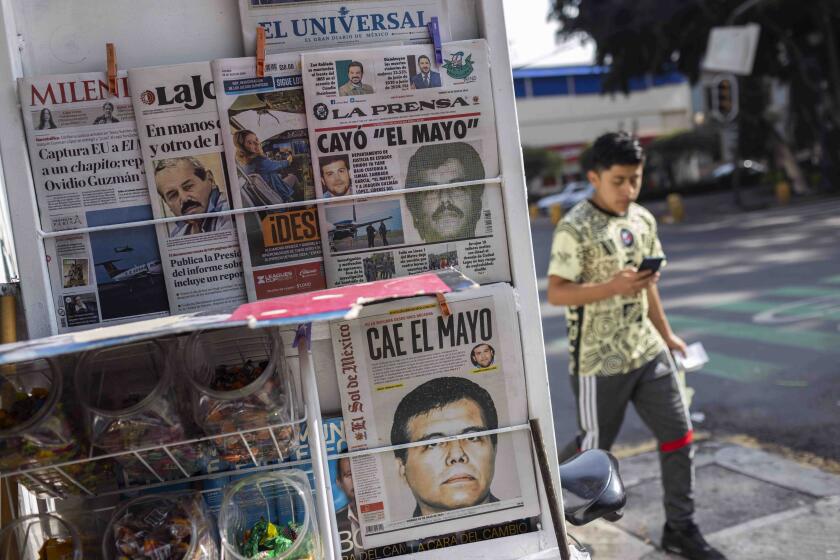Cause of New Mexico nuclear waste accident remains a mystery
A 55-gallon drum of nuclear waste, buried in a salt shaft 2,150 feet under the New Mexico desert, violently erupted late on Feb. 14 and spewed mounds of radioactive white foam.
The flowing mass, looking like whipped cream but laced with plutonium, went airborne, traveled up a ventilation duct to the surface and delivered low-level radiation doses to 21 workers.
The accident contaminated the nation’s only dump for nuclear weapons waste — previously a focus of pride for the Energy Department — and gave the nation’s elite ranks of nuclear chemists a mystery they still cannot unravel.
Six months after the accident, the exact chemical reaction that caused the drum to burst is still not understood. Indeed, the Energy Department has been unable to precisely identify the chemical composition of the waste in the drum, a serious error in a handling process that requires careful documentation and approval of every substance packaged for a nuclear dump.
The job of identifying the waste that is treated and prepared for burial will grow even more difficult in the years ahead when the Energy Department hopes to treat even more highly radioactive wastes now stored at nuclear processing sites across the country and transform them into glass that will be buried at future high-level dumps.
The accident at the facility near Carlsbad, N.M., known as the Waste Isolation Pilot Plant, or WIPP, is likely to cause at least an 18-month shutdown and possibly a closure that could last several years. Waste shipments have already backed up at nuclear cleanup projects across the country, which even before the accident were years behind schedule.
A preliminary Energy Department investigation found more than 30 safety lapses at the plant, including technical shortcomings and failures in the overall approach to safety. Only nine days before the radiation release, a giant salt-hauling truck caught fire underground and burned for hours before anybody discovered it.
The report found that “degradation of key safety management programs and safety culture resulted in the release of radioactive material from the underground to the environment.”
The 15-year-old plant, operated by a partnership led by San Francisco-based URS Corp., “does not have an effective nuclear safety program,” the investigation found.
The accident raises tough questions about the Energy Department’s ability to safely manage the nation’s stockpiles of deadly nuclear waste, a job that is already decades behind schedule and facing serious technical challenges.
“The accident was a horrific comedy of errors,” said James Conca, a scientific advisor and expert on the WIPP. “This was the flagship of the Energy Department, the most successful program it had. The ramifications of this are going to be huge. Heads will roll.”
There is no official estimate of the cost of the accident, but outside experts and a Times analysis indicate it could approach $1 billion, based on the WIPP’s annual budget; the need to decontaminate the facility; upgrades to safety that officials already have identified; and delays over the next decade in the nuclear weapons cleanup program.
The WIPP was designed to place waste from nuclear weapons production into ancient salt deposits, which would eventually collapse and embed the radioactivity for at least 10,000 years. The dump was dug much like a conventional salt mine, but with a maze of rooms for the waste. It handles low- and medium-level radioactive materials known as transuranic waste, the artificial elements — mainly plutonium — created in the production of nuclear weapons. Until the Valentine’s Day disaster, it had been operating without significant problems for 15 years.
The plant’s ventilation and filtration system was supposed to have prevented any of the radioactive material from reaching the environment. But investigators discovered that the Energy Department never required the ventilation system to meet nuclear safety standards. When monitors detected radiation, dampers were supposed to route the ventilation air into filters to prevent any radioactivity from reaching the surface, but the dampers leaked and thousands of cubic feet of air bypassed filters.
Luckily, the accident occurred when nobody was working in the mine itself. But the emergency response moved in slow motion.
The first high-radiation alarm sounded at 11:14 p.m. When control room managers tried to find the responsible on-call radiation control expert, they couldn’t find the person, according to the investigation report. By morning, workers were attempting to change filters. Not until 9:34 a.m. did managers order 150 or so workers on the surface of the site to move to a safe location, about 10 hours after the first alarm sounded. It took 13 hours for managers to staff an emergency operation center.
The radiation doses the workers received during the hours after the accident were a small fraction of the allowable occupational limits and the workers should have no health impacts, Energy Department officials said.
Although WIPP operating procedures were faulty, the dump itself did not cause the accident. The steel drum was packaged at the Los Alamos National Laboratory in New Mexico. The drum principally contained nitrate salts, a byproduct of the chemical process that extracts plutonium, used in the triggers of hydrogen bombs.
Investigators believe that some chemical or packaging change was made at Los Alamos, and they are looking at whether that change was ever approved by senior laboratory chemists. A team of experts from WIPP may also have missed the change.
The investigators are looking at a variety of materials that may have been added to the drum, including lead, tungsten, acid and even kitty litter as possible factors in the explosion.
“They haven’t been able to duplicate the reaction in a laboratory,” said Ed Lyman, a physicist with the Union of Concerned Scientists. “There is no guarantee that they won’t have another event in the future. The larger question here is how well they characterize nuclear waste so it will be safe.”
Other drums of the same material are still at the WIPP, as well as in storage at Los Alamos and at a private dump in Texas, and nuclear experts say another leakage accident cannot be ruled out.
Robert Alvarez, a former assistant energy secretary and a recent critic of the department’s performance, said the risk of a radioactive release at the WIPP was supposed to be one event every 200,000 years, not one in 15 years. “This was a cardinal violation,” he said.
Conca, among others, argues that the fundamental technology of the WIPP is sound, and he hopes officials do not overreact to the accident. But under the best of circumstances, the WIPP will probably be closed for 18 months, a shutdown that is causing concern in states that are already impatient with the Energy Department’s slow cleanup schedule.
The Energy Department has notified New Mexico officials that, as a result of the WIPP closure, it will fail to meet its deadlines for removing all of the 3,706 cubic meters of transuranic waste at Los Alamos.
At the Idaho National Laboratory, there are concerns that the WIPP closure could prevent the Energy Department from fulfilling its legal agreement to remove all transuranic waste by 2018. Curt Fransen, chief of the Idaho Department of Environmental Quality, said federal officials had begun discussing building new warehouses at the lab to store waste as a result of the WIPP accident.
At Washington state’s Hanford Site, the WIPP closure may lead to additional delays in shipping out 8,841 drums, boxes and other containers of transuranic materials to the New Mexico plant, said Deborah Singleton of the state’s Department of Ecology.
In Carlsbad, the closest city to the WIPP, officials have voiced support for the economically vital dump, but they also are worried about safety. When Energy Secretary Ernest J. Moniz went to Carlsbad this month, Jay Jenkins, president of Carlsbad National Bank, told him at a town hall meeting that he did not think the WIPP had adequate funding to ensure safety.
Moniz acknowledged such concerns, promising to ensure the future safety of the plant.
“You stick with us, and we’re sticking with you,” Moniz said.
More to Read
Sign up for Essential California
The most important California stories and recommendations in your inbox every morning.
You may occasionally receive promotional content from the Los Angeles Times.






